Lesson 5
Play and Brains
Lesson 5 investigates what play is and how it may differ between human children and non-human animals, particularly parrots. The evolutionary relationship between birds and humans is covered, and the differences between their brains is explored. The lesson covers questions such as:
Why do we play? Can you play without having fun? What is curiosity? How are humans related to parrots? How are bird brains different to ours? How might birds think?
Skills used:
- Curriculum: SCN 2-01a, SCN 2-14b, SCN 2-20a, SCN 2-20b
- Independent and group work.
- Discussion skills, such as reasoned arguments and debate.
- Applying information (eg. neuron system) to abstract issues.
Key Resources: (All resources can be downloaded in one go on the quick download page.)
Lesson slides, L5 – Lesson slides, prompting class discussion and activities.
Lesson plan, L5 – Overview of the lesson activities, as well as the goals and success criteria for the lesson. Links to videos are also given (though these are also embedded in the PP).
Teacher notes, L5 – Detailed notes and instructions following on from the lesson plan, including the stories from slide 3.
Annotated slides, L5 – Instructions for teachers, associated with the particular lesson slide.
Worksheets: (These resources can also be easily printed as part of the student work booklet)
Classroom quest worksheet – How can we find out information in different ways? Curiosity task associated with slide 7.
Bird brains worksheet – Summary of parrot brain activity, comparing different methods of getting neurons into the brain. (Slide 13)
Additional resources:
A Brief Guide to Bird Intelligence – Some wider background information specifically on birds – such as how their brains differ from other mammals and more details about research in this area.
